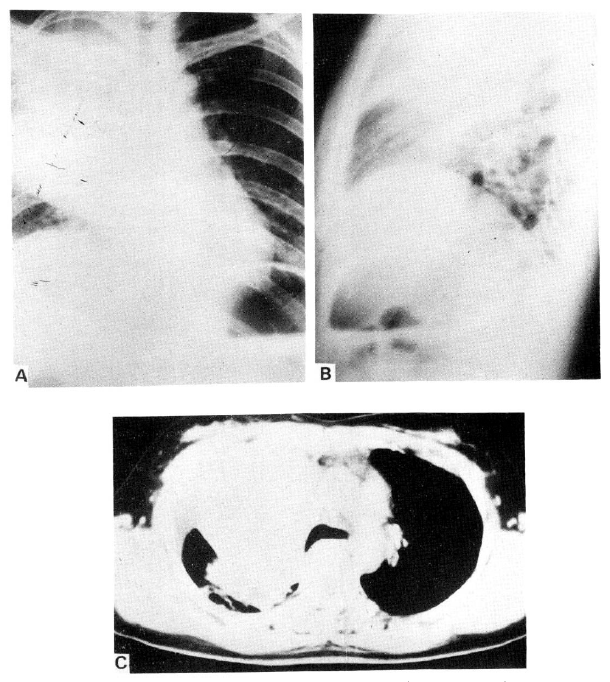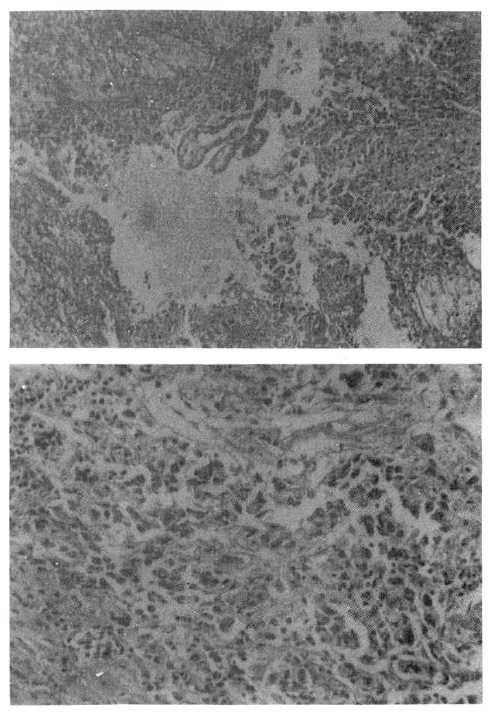INTRODUCTION
Primary extrauterine choriocarcinoma is very uncommon disease, that usually arises from retroperitoneum, mediastinum and it rarely occurs at any site (eg, intracranium, stomach, bladder, lung), especially primary lung choriocarcinoma is very rare disease. We report a case of primary lung choriocarcinoma which is confirmed by histological findings of choriocarcinoma on lung biopsy. Also we could not find any other focus of choriocarcinoma.
CASE
A 33-year-old woman was admitted with dyspnea tor the previous 3 days. About 20 days before this admission she had suffered from dry cough, weight loss and generalized weakness and more aggravated.
Past medical history except a episode of the operation of the H-mole about 6 years ago was unremarkable.
On physical examination, the patient appeared to be severely emaciated and dyspneic.
The blood pressure was 120/80 mmHg, Pulse rate 90/min, respiration rate 30/min, and temperature 36.8°C. Mild anemic conjunctiva was seen. Decreased breathing sound on auscultation and dullness at percussion on right lung field and rapid heart beat without murmur were seen.
The other parts were normal.
Hemoglobin was 10.6 gm/dl, and white blood cell count was 9500/mm3 with 57% neutrophils.
Chest X-ray showed a homogenous hyperdense mass density with a collapse on the right upper & middle lung field (Fig. 1-a, b).
On the 2nd hospital day, fiberoptic bronchoscopy was performed, it revealed hyperemic edematous changes in the right upper bronchus.
Thus a chest C–T scan was performed, it showed that huge tumor was visible with irregular thickening and adhesiion of the pleura on the right chest (Fig. 1-c).
A percutaneous transthoracic needle lung biopsy was perforemd and the patent was histologically diagnosed as choriocarcinom (Fig. 2).
On thyroid scanning, an inferior extension of radioactivity of right lobe was seen and on thyroid function test t3 3.29 (0.8–2.0) T4 23.5 (5–13), free T4 108.9 (9.4–25) and TSH 0.69.
Pelvic physical and ultrasound examination were non-specific, and B-HCG titer was 200,000 IU/I over.
Abdominal C–T scan was performed for the detection of other problems. The results were good.
So chemotherapy with MTX, actinomycin-D, cyclophosphamide was performed for consecutive7 7 days. Thoracentesis and prednisone were added for symptom relieve.
After chemotheraphy the B-HCG titer decreased 27,690 IU/L & symptoms were partial relived.
DISCUSSION
Choriocarcinoma is highly malignant disease that arises from hydatidiform moles, normal pregnancy and abortion.
Extrauterine choriocarinoma is also occurs in the absence of pregnancy as well as in male1), which usually developed in retroperitoneum and mediastinum. But rarely primary choriocaricinoma occured in ovary, stomach, bladder and lung2–7).
Choriocarinoma arises from the genital tract, which most frequently metastases to the lung, So diagnosis of primary lung choriocarcinoma should be careful conclusion after perfect examination of genital tract & other foci of choriocarcinoma.
In the case of this patient the diagnosis was based on the data of serum B-HCG titer, histologic examination and definite lesion was found only in the lung.
We studied all orgns for the detection of foci of choriocarcinoma by radiologic examination (eg, ultrasonogram, computerized tomogram), physical and labolatory examination. In this case, no primary lesion was found in digestive system & genital tract other than that in the right lung. Serum B-HCG titer was elevated over 200,000 IU/L. Sometimes large cell anaplastic carcinoma, mediastinal germ cell tumor, broncogenic carcinoma showed ectopic HCG secretion, but this elevations is mild8–12). So this high B-HCG level suggested trophoblastic origin.
After chemotherapy, B-HCG level fell 27690 IU/L in serum.
On histologic examination, a neoplastic cytotrophoblast with large nuclei and syncytiotrophoblast was found. And sometimes some trophoblastoid cells has been found among the component of lung cancer, but in our patient, other malignant component was not detected.
On the basis of the above mentioned substantial evidence, we concluded primary choriocarcinoma of the lung. Extrauterine choriocarinoma arises from multipontential germ cells remaining from the embryonal period and result of differentiation of gastric carcinoma and teratoma6).
In this patient had not another malignancy.
Another genesis theory of primary choriocarcinoma of the lung is that at the time of pregnancy, abortion, normal delivery, some of the tissue entering the blood vessel of the mother, may produce pulmonary emboli, which develop malignancy and transformation into choricoarcinoma7).
Emobolism of placental tissue to lung has been developed in abnormal deliveries, abortion and deliveries13).
In this patient, the occurrence of primary lung choriocarcinoma is due to pulmonary embolism by trophoblast.





 PDF Links
PDF Links PubReader
PubReader ePub Link
ePub Link Full text via DOI
Full text via DOI Download Citation
Download Citation Print
Print





